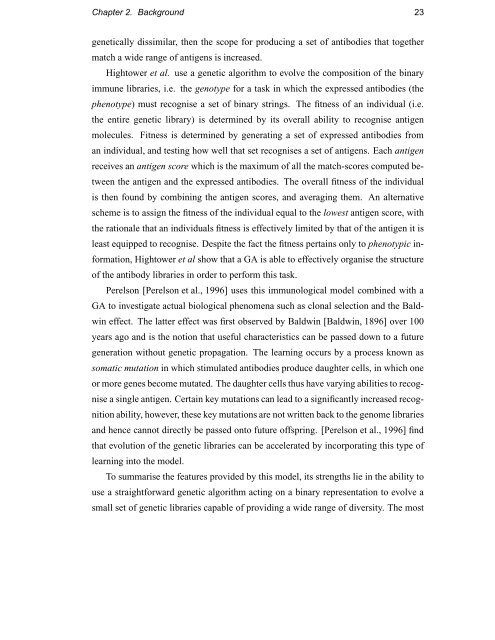Immunology as a Metaphor for Computational ... - Napier University
Immunology as a Metaphor for Computational ... - Napier University
Immunology as a Metaphor for Computational ... - Napier University
You also want an ePaper? Increase the reach of your titles
YUMPU automatically turns print PDFs into web optimized ePapers that Google loves.
Chapter 2. Background 23genetically dissimilar, then the scope <strong>for</strong> producing a set of antibodies that togethermatch a wide range of antigens is incre<strong>as</strong>ed.Hightower et al. use a genetic algorithm to evolve the composition of the binaryimmune libraries, i.e. the genotype <strong>for</strong> a t<strong>as</strong>k in which the expressed antibodies (thephenotype) must recognise a set of binary strings. The fitness of an individual (i.e.the entire genetic library) is determined by its overall ability to recognise antigenmolecules. Fitness is determined by generating a set of expressed antibodies froman individual, and testing how well that set recognises a set of antigens. Each antigenreceives an antigen score which is the maximum of all the match-scores computed betweenthe antigen and the expressed antibodies. The overall fitness of the individualis then found by combining the antigen scores, and averaging them. An alternativescheme is to <strong>as</strong>sign the fitness of the individual equal to the lowest antigen score, withthe rationale that an individuals fitness is effectively limited by that of the antigen it isle<strong>as</strong>t equipped to recognise. Despite the fact the fitness pertains only to phenotypic in<strong>for</strong>mation,Hightower et al show that a GA is able to effectively organise the structureof the antibody libraries in order to per<strong>for</strong>m this t<strong>as</strong>k.Perelson [Perelson et al., 1996] uses this immunological model combined with aGA to investigate actual biological phenomena such <strong>as</strong> clonal selection and the Baldwineffect. The latter effect w<strong>as</strong> first observed by Baldwin [Baldwin, 1896] over 100years ago and is the notion that useful characteristics can be p<strong>as</strong>sed down to a futuregeneration without genetic propagation. The learning occurs by a process known <strong>as</strong>somatic mutation in which stimulated antibodies produce daughter cells, in which oneor more genes become mutated. The daughter cells thus have varying abilities to recognisea single antigen. Certain key mutations can lead to a significantly incre<strong>as</strong>ed recognitionability, however, these key mutations are not written back to the genome librariesand hence cannot directly be p<strong>as</strong>sed onto future offspring. [Perelson et al., 1996] findthat evolution of the genetic libraries can be accelerated by incorporating this type oflearning into the model.To summarise the features provided by this model, its strengths lie in the ability touse a straight<strong>for</strong>ward genetic algorithm acting on a binary representation to evolve <strong>as</strong>mall set of genetic libraries capable of providing a wide range of diversity. The most









![Unit 5. Switches and VLANs [PDF]](https://img.yumpu.com/34422504/1/184x260/unit-5-switches-and-vlans-pdf.jpg?quality=85)






